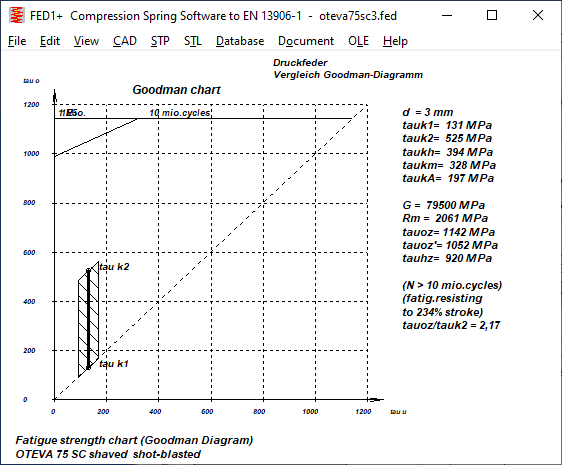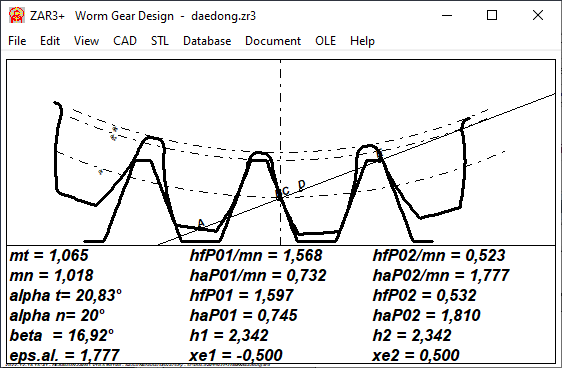
 | English
| Deutsch
| English
| Deutsch
FED1+,2+,3+,5,6,7,8,17: Fatigue strength coefficient and life expectation
EN 13906-1 contains Goodman diagrams as fatigue strength diagrams for 10 million load cycles and fatigue strength diagrams for 1 million load cycles. A Goodman diagram as a fatigue strength diagram for 1 million load cycles is available for cold-drawn springs made from patent-drawn spring wire of grade DH or SH, shot-peened, and from oil-tempered wire of grade TD or FD (TDC or FDC), shot-peened, and for hot-formed springs made from hot-rolled EN steels 10089 with ground or peeled surface, shot blasted. With these fatigue strength diagrams, the permissible variation of stress between two loads for 1 million load cycles (1E6 = 10^6) are approx. 25% higher than for 10 million (1E7 = 10^7) load cycles. This means that if the springs are overloaded by 25% of the permissible fatigue strength value for >=1E7 cycles, they will fail after 1 million load cycles. It is generally the case that the permissible overload is lower the higher tensile strength, hardness and brittleness of the material. This is also confirmed by the new Goodman diagrams from the IGF project 19693BR for 1E6 and 1E7 load changes. A new field was added to the materials database fedwst.dbf for the individual adjustment of the fatigue strength: E6_E7 is the quotient of the permissible shear stress at 1 million (1E6) and at 10 million (1E7) load cycles. According to EN 13906-1, this factor is 1.25 for all fatigue strength diagrams shown there, i.e. the permissible variation of stress between two loads for 1 million load cycles is 25% higher than for fatigue strength safety (>=10 million load cycles). With the new Goodman diagrams according to IGF 19693 and VDFI L-001, this fatigue strength factor is somewhat smaller: E6_E7=1.15 for 1.4310 and 1.4568, E6_E7=1.1 for DH, VDSiCr and VDSiCrV. If you want to enter your own fatigue strength diagrams into the database, you can use this factor E6_E7 to define the fatigue strength range. The factor E6_E7 is also included in the service life calculation: If, for example, the variation of stress between two loads taukh is 20% above the value from the fatigue strength diagram, this results in a life expectation between 1 million and 10 million load cycles with E6_E7=1.25. For E6_E7=1.15, the life expectation is less than 1 million load cycles. If the fatigue strength factor E6_E7 deviates from the default value of 1.25, it is now listed in the Goodman diagram.

FED1+,2+,3+,5,6,7,8,17: FEDWST.DBF with data field E6_E7

Since December 1, 2022, the materials database fedwst.dbf contains an additional field E6_E7 with the fatigue strength factor E6_E7 = tauhzE6 (N=1E6) / tauhzE7 (N=1E7). In the materials according to EN 13906-1, this factor is calculated with 1.25. If the new field E6_E7 is empty, 1.25 is used. Ultra-high-tempered materials are more sensitive to overstress, so the factor for the following materials was set to 1.1: Oteva 70, 74, 75, 76, 90, 91, 96, 100, 101, Garba 177.


Goodman diagram Oteva 75 SC peeled and shot-peened E6_E7=1.1 (from 12/22) and E6_E7=1.25 (old)
The modified fatigue strength factor only has a practical effect on the service life calculation in this example if the prestress is small (tauk1<300MPa) and the stress variation between two loads is very high (taukh>900 MPa). With a higher preload (tauk1>300) the stroke is limited by the (static) permissible shear stress, and with a smaller stroke stress (taukh<900) the spring is fatigue strength safe (>=1E7 cycles) for tauk1<300 MPa (numerical values only apply to this example of Oteva 75, d =3mm, shot peened).
FED2+: Setting tau/sigma for Goodman diagram

The Goodman diagrams for bending stress in the loops are converted from the Goodman diagrams for torsional stress with a factor tau/sigma. For helical compression springs, tauz=56% Rm according to EN 13906-1, for tension springs, tauz=45% Rm according to EN 13906-2, for torsion springs, sigmaz= 70% Rm according to EN 13906-1. In FED3+, therefore, tau/sigma = 0.56Rm/0.7Rm = 0.8. Up to now, tau/sigma=0.5Rm/0.7Rm = 0.715 was used for the loops stress of the tension springs. With the setting tauo=tauz=0.56Rm then sigmaoz=tauoz/0.715 = 0.56Rm/0.715 = 0.78Rm. According to EN 13906-3, the permissible bending stress for torsion springs is 0.7 Rm (in general mechanical engineering, the permissible bending stress is Sigma = 1.0 Rm). Now you can set under "Calculation method" whether you want to display the Goodman diagram for loop stress as before, or with the conversion factor tau/sigma = 0.56Rm/0.7Rm = 0.8 as for torsion springs. In this setting, sigmaoz=sigmaz is also the same for tauoz=tauz. In the new setting, the permissible bending stresses Sigma are somewhat smaller, as is the calculated life expectation (loop).
SR1/SR1+: Enter material data for nut thread

Previously, the material for the bolt and nut had to be selected from the database. Now you can also enter the material data individually without having to expand the database. However, there is not enough space for this in the Quick input, so you have to use the input window under "Edit\Nut".
WN2+: ISO tolerance A..V instead of A..S

In WN2+ you could extend the range of the ISO tolerances from "F..M" (according to DIN 5480) to ISO tolerances "A..S" for the hub profile. Now the range has been extended again by T,U,V, to tolerances "A..V" instead of "A..S".
ZAR3+: Tooth height factors with tooth profile drawing

The entered tooth height factors are calculated with "Calc Profile" and a tooth shape drawing of the worm and worm wheel is displayed in the background window now.

Tip: Back up databases for updates
If you have expanded or changed databases yourself, you must back them up with updates. Then decide whether to continue using the old databases with the new version or to replace or update them with the new data. Even if you have not changed any databases, it can make sense to back up the old status. How so? If, for example, material properties have been changed and you open an old calculation, a different result is displayed than it was then. Just save the old dbf files in a folder, e.g. dbf2022. You can then easily switch between old and new database files under File\Settings\Directories.
Tip: Change setting "copy dbf->Temp" and databases for network versions
For network versions there is a setting "copy dbf->Temp" under File\Settings\Directories. With this setting, all dbf files are copied to the temporary directory when the program starts. The program usually runs faster because there is no more network access. Requirement: The temporary directory must be configured to the local computer, e.g. "c:\temp". This setting has proven its worth, especially in the home office, when working at home with the floating license in the company. It has now turned out that this setting not only has advantages: You cannot change any databases in this setting because only the dbf file in the temporary directory is changed. If you want and are allowed to change databases, you should deselect this option, save the settings, exit the program and restart.
Tip: cfg configuration in "C:\HEXAGON\"
When the program starts, the configuration is loaded from the working directory. The working directory can be found by right-clicking on the program icon under "Properties", "Run in". A new cfg file is saved or overwritten by pressing the "Save" button in the program under "File\Settings". If no cfg file is found in the working directory, the program searches under "C:\HEXAGON\". If there is no cfg file there either, it will start without configuration. This works fine if all files are in the same folder. If the program is started by clicking on a data file, then the working directory is the location of this data file. A cfg file is usually not found here, then the configuration is loaded from "C:\HEXAGON".
If you use several versions of a program, e.g. a German and an English version or a single-user license and a floating license, you need a separate cfg configuration in the working directory for each version. Otherwise the cfg file is always loaded from "C:\HEXAGON".
Words of the year 2022
Ukraine - war of aggression - sanctions - energy crisis - inflation - gas price cap - climate change.
Relegated of the year 2022:
Corona - killer variant - booster vaccination - isolation requirement - mask requirement - vaccination requirement. Corona has lost its terror among the majority of the population worldwide. After almost half of the population in Germany and other countries has a proven corona infection behind them, expert advice can be dispensed with. Own experience is the best expertise.
China probably still has an infection with the corona virus ahead of it. From a western point of view, it is astonishing that there is no compulsory corona vaccination in authoritarian China. The Republic of Austria and the Federal Republic of Germany acted more dictatorially than the People's Republic of China.